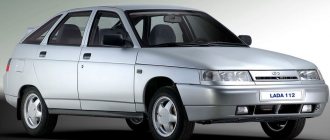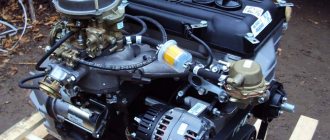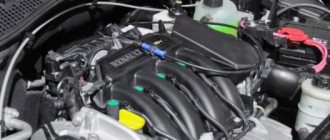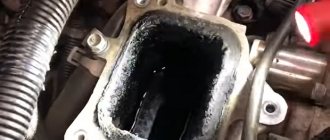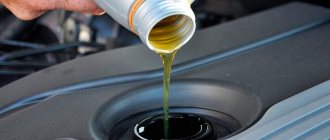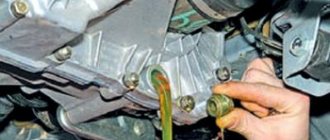When choosing a new car, it is recommended to familiarize yourself with the technical characteristics and operational features of internal combustion engines offered by well-known manufacturers. The article presents an atmospheric engine, which is very popular among motorists due to its many advantages. The design of the power unit does not have a turbocharger; air-fuel mixtures are formed using a pressure equal to one atmosphere.
What is a naturally aspirated engine
Not all car owners understand what a naturally aspirated car engine means. These are gasoline engines of a classic design that pump air from the surrounding space using carburetor pistons. When oxygen is uniformly mixed with atomized gasoline particles, fuel mixtures are formed. They are used for combustion in the combustion chamber of a gasoline engine.
Operating principle of an atmospheric engine:
- Suction of air from the atmosphere.
- Mixing with gasoline vapors in the following proportions: gasoline - 1 part, oxygen - 14.
- Supplying the mixture to the combustion chamber.
- Volume expansion.
- Pressure on the piston.
- Transmission of rotation to the crankshaft.
The effect of suction of air masses occurs due to the creation of a rarefied atmosphere in the cavity of the intake manifold.
conclusions
Gasoline and diesel naturally aspirated engines are an ideal unit in terms of reliability and service life. Due to the absence of complex structural components, it can be independently repaired and maintained. It is not difficult to pair such an engine with gas to save on fuel consumption.
However, the naturally aspirated engine is too limited in its ability to increase power without harming the system and comfort of movement. Also, the increase in power in his case is directly proportional to the increase in fuel consumption. For these reasons, turbines are increasingly being used in new cars.
With the invention of the first automobile engines, atmospheric-type power units were created. Atmospheric engines are internal combustion engines that use air from the atmosphere to form an air-fuel mixture.
The pressure of the air flow supplied to the engine is equal to one atmosphere, for this reason such power units are called atmospheric. The fuel mixture for an atmospheric engine consists of one part gasoline and fourteen parts air.
Many car owners often wonder what a naturally aspirated engine means. The name arose due to the pressure of the drawn air corresponding to the environment. Air is necessary to participate in the combustion of fuel mixtures in the combustion chambers of power units. The pistons draw air masses through the injector into the carburetor, where they are evenly mixed with injected gasoline or diesel fuel.
The tightening capacity of the motor is directly dependent on the number of engine revolutions. An atmospheric engine is distinguished by the absence of special devices in the form of compressors or turbines used for additional forced injection of air under pressure.
What is the difference between a naturally aspirated engine and a turbocharged one?
It is known that the quality of fuel combustion and the amount of energy pushing the pistons depend on the volume of air supplied to the cylinders. The larger the engine, the more power and torque the aspirated engine develops.
Unlike turbocharged engines, naturally aspirated engines do not provide for forced intake of air flows under pressure. Aspirated engines are characterized by reliability; they are resistant to detonation. Thanks to the use of lubricating fluids made on a synthetic basis, losses due to overcoming friction forces are significantly reduced. Due to the improvement of valve timing adjustments, ultra-precise fuel injection is carried out under the control of an electronic system.
In order to improve the technical characteristics of the engine, models with large displacement cylinders in the amount of 6 to 12 pieces are used. However, an increase in volume in the engine building industry is not always considered advisable, since this leads to a heavier structure.
Pros and cons of naturally aspirated engines
With the advent of power units equipped with a turbocharger, many drivers began to prefer turbocharged vehicles. However, there are many motorists who, when asked which engine is better, naturally aspirated or turbocharged, choose the usual classic option, based on the following advantages:
- Long service life.
- Simplicity of the device.
- No serious problems during operation.
- Availability of DIY repairs and maintenance.
- Reduced engine oil consumption.
Atmospheric internal combustion engines have the longest mileage. There are known cases when cars with installed aspirated engines operate without major repairs along the way, more than 500 thousand kilometers. The only condition is timely care and regular replacement of engine oil and filters. Their parts and components are wear-resistant. The reliable naturally aspirated engine has an increased service life and continues to work even after repeated replacements of the car body.
Thanks to the trouble-free operation of the naturally aspirated engine and the ease of its operation, it is unpretentious to the quality of fuel and lubricants. With regular use of gasoline of reduced quality, such engines, even if they fail, quickly restore their performance. The main requirement for motor oil is to ensure the required level. The lubricant should be replaced every 15 - 20,000 km. When choosing the most suitable brand of motor oil for a naturally aspirated engine, it is recommended to give preference to synthetic or semi-synthetic.
Interesting: Unlike a turbocharged engine, you can also use mineral oils here if you were unable to purchase better lubricants.
The simplicity of the aspirated design allows some repair work to be carried out even in a garage. When contacting a car service center, the cost of services is several times lower compared to repairing similar faults in turbocharged engines.
Atmospheric internal combustion engines have some disadvantages:
- Relatively heavy weight of the mechanism.
- Reduced power and developed torque compared to a motor equipped with a turbine.
- Aspirated engines are not designed to operate under heavy loads.
- Difficulties in operating at high altitudes in thin air conditions.
- When a naturally aspirated engine operates at low speeds, a sufficient amount of air is not always sucked in, which affects the stability of operation.
Flaws
Despite all the advantages of “aspirated” engines, you can still find some disadvantages in them. One disadvantage is the weight. Due to their design and operating principles, atmospheric engines are heavier and more voluminous, and as we know, the weight of the car as a whole affects the average fuel consumption. In terms of power and dynamics, they are noticeably inferior to engines with turbocharging with the same volumes. The fact is that the engine power system, due to its independent supply of oxygen from the environment, does not always allow for the exact proportions of fuel to air, which should be equal to 1 to 14 in all operating modes. Consequently, at lower speeds the engine sucks in less air, and at high speeds it is hampered by the flow area of the air ducts and the resistance of the air filter. Operational efficiency generally decreases, since while driving it is not possible to maintain a narrow range of obtaining a combustible mixture, compared to a turbocharged internal combustion engine.
IMPORTANT! For more gentle operation of the engine, it is recommended to press the gas pedal smoothly and not load the engine at high speeds.
Examples of vehicles with powerful naturally aspirated engines
The modern car market features naturally aspirated cars produced under well-known brands:
- Mercedes C 63 FMG Coupe Edition 507.
- Chevrolet Corvette C 7 Stingray.
- Jeep Grand Cherokee SRT.
- Audi RS 5.
- Audi RS 4 Avant.
- Chevrolet Camaro.
- Mercedes SLK 55 AMG.
- Porsche Cayenne GTS.
- Infiniti QX 70.
- Lexus LS 460.
- Mercedes-Benz OM 602.
- OM 612.
- OM 647.
- BMW M57.
Which is better - naturally aspirated or turbocharged engine?
There is no clear answer to this question. Any of the presented motors has its advantages and disadvantages. To understand whether a naturally-aspirated or turbocharged engine is best for you, it is recommended that you familiarize yourself with the features of their operation.
Unlike atmospheric ones, turbocharged power units have a significant feature: air is not sucked in here, but is forced into the air using an installed turbine. At the same time, engine characteristics such as torque and power are significantly improved.
Many drivers want to improve the dynamics of the vehicle, as a result they have a natural question: is it possible to install a turbine on an existing naturally aspirated engine and, if so, how to do it.
This possibility exists, it all depends on the model of your car. There are situations when it is more profitable to acquire a new car than to purchase expensive parts for chipping and pay for the work of craftsmen. To install a turbine on an atmospheric engine, it is necessary to invite a qualified mechanic with experience in carrying out such work.
Diesel engines equipped with turbocharging are called turbodiesels. The turbocharged power unit includes a turbocharger, which forces air into the diesel intake manifold under high pressure.
Interesting: Unlike naturally aspirated diesel engines, when operating in high altitude conditions, turbodiesels provide the most complete combustion of fuel. Among experts, this effect is known as “car height.”
Atmospheric device
How the engine works can be seen using the example of a four-stroke naturally aspirated one. Based on their functions, motor parts are divided into approximately 4 groups:
- To ensure the intake and ignition of fuel-air mixtures. This group includes the cylinder head and valve mechanism.
- Parts to ensure compression of the air-fuel mixture. This group consists of pistons, piston rings, cylinder block, valve.
- To transmit motor energy. The group contains connecting rods, a crankshaft, bearings and flywheels; they can be purchased here: /uzp.net.ua/ru/podshypnyky/.
- Parts for producing spark flashes. The group is filled with spark plugs and distributors.
The interaction of these engine parts ensures the main rotation of the wheels.
Cylinder head
This is the main part of the engine, located directly above the cylinder block. It is constantly exposed to combustion gases that have high temperature and pressure. The part is made of sheet iron or aluminum alloy with high-strength and high-temperature additives.
Valves and related parts
Modern four-stroke engines have 4 valves for each cylinder: 2 intake and 2 exhaust. To ensure efficient intake, the intake valve has a larger diameter than the exhaust valve. They are made from high temperature nickel or chrome steel.
Each valve has accompanying parts: a seat and a spring, which is spiral and creates close contact with the seat, preventing gas leakage. Typically, engines use one spring, but in some types 2 are installed for each valve.
When the valve is closed, the seat is in close contact with the valve surface to ensure a tight combustion chamber.
The cylinder block forms the frame of the engine. Together with the pistons, the cylinder block plays an important role in ensuring that compression and combustion pressures are overcome. To minimize wear of parts and gas leaks, the inner surface of each cylinder is separated by high pressure chrome plating.
The cylinder hole is made circular. However, the upper part of the cylinder and piston suffers from wear due to high pressure and temperature. Later, the gap between the piston rings and the cylinder increases, leading to compression losses.
Motor piston
The part moves up and down in the cylinder under the influence of pressure generated by explosions of the fuel-air mixture. In this case, the piston rotates the crankshaft through the piston pin and connecting rod. The cross-section of the piston is not a perfect circle: the diameter in the direction of the piston pin is made slightly smaller to allow thermal expansion to escape.
The piston head becomes much hotter and expands more than the skirt. To compensate for the difference in thermal expansion, the diameter of the piston at the top is made smaller than at the bottom. The rings prevent leakage under compression pressure of the mixture through the gap between the cylinder and the piston. Typically each piston has 3 rings.
Unit connecting rod
It connects the piston to the crankshaft so that the vertical movement of the piston is converted into rotational movement of the crankshaft. Since the connecting rod is subject to continuous forces of compression and tension, it must be quite strong and well supported to withstand these loads.
Crankshaft
This part converts the linear motion of each piston into rotational motion through the connecting rod. It consists of crankpins that transmit the force of the pistons and shaft, crankpins that regulate the rotation of the shaft, and balancing weights that ensure good, balanced rotation of the shaft.
The crankshaft rotates at high speed, subject to heavy loads from the pistons, so it must be quite strong and secured, as well as well balanced both statically and dynamically.
